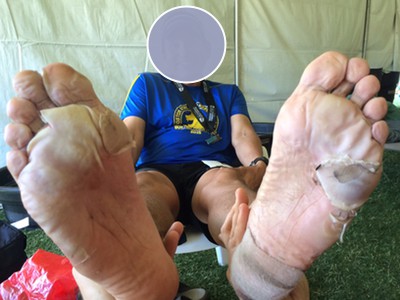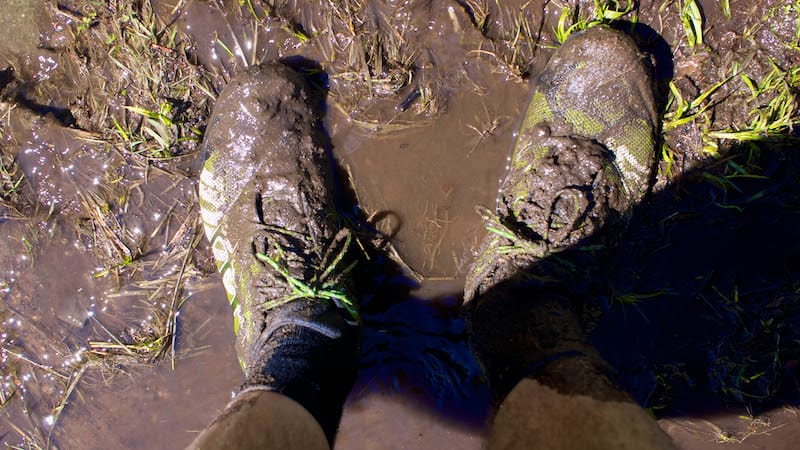Introduction
In response to an article I posted recently about crossing streams in your hiking shoes, @impalatrash replied via Twitter to share their experience with trench foot.
Nice article but with wet feet comes the risk of trench foot. Which I didn’t know was possible but after one day of wet feet I was off trail for 9days. If I had hiked on it could have caused permanent damage. I still just cross but now rub vaso in 3 times a day.
— Impala_trash (@impalaontrail) July 18, 2019
The purpose of this article is to clear up some confusion about trench foot, other immersion foot diseases, and maceration, and provide some context for backpackers who are worried about it.

What is immersion foot?
Immersion foot refers to a type of diseased condition that results when your feet are continuously wet for extended periods of time.
The most well-known of these conditions is trench foot (TF). Related conditions include tropical immersion foot (TIF) and warm water immersion foot (WWIF).
For a backpacker, understanding the differences between these three distinct diseases aids in diagnosing the right condition. Knowing what disease you are manifesting will allow you to optimize subsequent treatment so you can return to the trail as soon as possible without suffering permanent damage.
It’s often assumed that the three diseases are distinguished by the temperature of the water that causes the immersion foot disease, but that’s not the entire story. It is true that TF usually occurs in cold conditions (temperatures above 32 deg F but less than about 60 deg F) and that TIF and WWIF usually occur in warm conditions (temperatures greater than about 60 deg F).
Other than the temperature of the water that causes the disease, the nature of the disease and the symptoms between cold water immersion disease (TF) and warm water immersion diseases (TIF and WWIF) are notably different.
Trenchfoot occurs primarily when the feet are exposed to cold temperature water for extended periods of time. It occurs far more rapidly when the feet are continuously immersed or otherwise soaking wet (as what might occur if you are walking through an Alaska tundra swamp during snowmelt), instead of intermittently immersed (as what might occur if you are wading cold rivers in the High Sierra several times a day).

Water immersion, whether in cold or warm water, causes maceration (“pruning”) of the foot’s dermal tissues. However, maceration (which is simply the byproduct of supra-hydration of dermal tissues) tends to be more pronounced in TIF and WWIF.
With TF, it’s the combination of water immersion with cold temperatures that creates a different set of problems – vasoconstriction to the foot’s surface tissues (dermal layers). Once the blood supply has been restricted for a significant period of time, tissues start to die, which makes them more prone to bacterial infection. As a result of tissue death and bacterial growth, blisters and open sores occur more easily – which creates even more avenues for infection. Trench foot can be halted in its early stages, but if allowed to progress, can lead to gangrene and permanent nerve damage.

Another primary difference between TF and TIF/WWIF is that trench foot can occur more rapidly, and progress to a fairly advanced state within the course of a single day’s march (e.g., 12-14 hours). TIF and WWIF, on the other hand, progress more slowly, and usually requires 48-72 hours or more to manifest themselves.
Although the pathology behind all immersion foot diseases is complex and not well-understood, it is generally accepted that trench foot is caused primarily by cold-induced vasoconstriction, and TIF/WWIF are caused by the maceration-induced separation of dermal layers.
Other than these causative differences, all immersion foot syndromes share similar symptoms:
- extreme maceration
- dermal layer separation
- redness
- tenderness
- swelling
- blisters
- sloughing skin
- open sores
How to prevent immersion foot disease
Now, how does an understanding of these diseases affect the backpacker?
First and foremost, consider that if your feet are exposed to wet conditions for several hours, the very first thing that you are going to notice is maceration:
Maceration is the softening of the dermal tissues of the foot as a result to these tissues become overhydrated due to sustained water exposure.

The primary symptoms of maceration are white, wrinkly feet. In the early stages of maceration, there should be little or no tenderness, redness, or swelling. As a result of the softening and wrinkling of the tissues, you may begin to notice some cracking or blistering of the skin.
At this point, you don’t have an immersion foot disease but do consider the maceration as a warning sign that needs to be addressed.

In my research on this topic, one of the most mind-blowing themes I discovered was that there seems to be no limit to the amount of water your dermis and epidermis can absorb (ref. 3). The implications of this are profound because we can no longer assume that the skin becomes “saturated” at some point, and then all’s good. The bottom line is that the more you expose your feet to saturated conditions without drying them out fully, the more that maceration will develop, and the risk of dermal layers separating from each other increases. Consider early wrinkling, whitening, and softening of your foot skin to be a canary in the coal mine for something down the road that could cause permanent damage and require weeks or even months of healing.
And this brings me to the most important consideration for backpackers: preventing and managing maceration should be your focus, not worrying about full-blown immersion foot diseases. Control maceration and your feet won’t degrade further, regardless of water temperature.
There are a number of things you can do to help prevent maceration, and manage it once it starts:
- Use a hydrophobic balm as a barrier. Maceration is the softening and wrinkling of dermal tissues as a result of supra-hydration of those tissues. So let’s prevent water absorption into the tissues in the first place – use a hydrophobic balm. @impalatrash noted in the tweet in the introduction to this article using Vaseline, which is very hydrophobic but tends to wash off the skin in just a few hours. Balms containing ozokerite waxes are among the most effective due to the high melting point of the waxes, which helps maintain a water absorption barrier through the dirty and damp activity of long-distance hiking. Apply to the entire surface of the foot, use liberally, and reapply frequently.
- Wear merino wool socks rather than synthetic socks. Socks that have a higher content of merino wool fibers are better than socks made with predominantly synthetic fibers. Wool fibers absorb water into the fiber, which keeps it away from the skin surface. Synthetic fibers are non-porous and result in clammier, wetter feet.
- Change blister dressings and tapes frequently. Encasing a portion of your foot in tape and blister dressings can create localized areas of macerated skin that can cause problems in the long run. Remove dressings at night, allow your feet to dry out, and reapply them in the morning.
- Wear shoes that drain. Hiking shoes with mesh uppers and/or engineered drainage ports allow you to pump water out of your shoes. Maceration progresses rapidly if your feet are submerged in water inside your shoes!
- Drain your footwear after a river crossing. When you reach the dry side of a river crossing or otherwise wet area, remove your shoes and socks, drain your shoes, and wring your socks out. This removes most of the water and can put you on a path to drier feet more rapidly. See the Crossing rivers and water shoes article.
- Take off your shoes and socks at rest breaks. If it’s the middle of the day and you can afford to stop for a break, take off your shoes and socks and allow your feet to air dry for a bit. It’s going to take more than an hour to reverse the maceration process, but this will help prevent it from getting worse by keeping your feet in wet shoes and socks during your rest breaks.
- Change into dry socks during the day. If your water exposure is intermittent and you know that you’re heading into a significant dry stretch, change into dry socks. If you’re able to plan your water immersion/dry stretches at all, consider wearing wet socks in wet stretches of your route and change into dry socks for dry stretches of your route.
- Slow down your pace. Your feet are now compromised and the tissue softness and wrinkling are going to make you more susceptible to cracking and blistering. Fast-paced hiking + heavy pack weights may be two of the biggest (controllable) culprits when it comes to exerting the shear stresses on foot skin surfaces that lead to cracking and blistering.
- Stop and camp. If you’re on a multi-day trek – the best possible thing you can do is allow your feet to dry at night. If it’s warm, sleep without socks. If it’s cool, sleep only in dry socks that are as thin as possible to maintain foot warmth and comfort. Cold feet at night doesn’t help recovery, due to poor vascular circulation in your feet. You need that warm blood flowing in order to heal at night!

Do I need to get off the trail?
Finally, if you note that your feet have been macerated for several hours or days, and any of the following symptoms manifest, you may be progressing into an immersion foot disease:
- redness
- tenderness
- swelling
- open sores/sloughing skin
At this point, the chance that you can reverse conditions while on the trail is extremely slim. It’s time to get off the trail and rest your feet for a week or more. It may take up to several weeks for your foot to grow new dermal layers of skin, depending on the extent of the damage. If your feet are discolored (blue, black) or open wounds appear to be infected, it’s time to see a doctor as well.
References and Author Notes
- Listen to our podcast about Maceration and Immersion Foot.
- Immersion Foot Syndromes (Wikipedia) – not a terrific summary, but I suppose it’s worth starting somewhere if you don’t have the patience to dig into medical writing.
- Nonfreezing cold water (trench foot) and warm water immersion injuries (UpToDate) – a much better summary of immersion foot disease than the Wikipedia article linked above, probably because this one’s actually put together by medical experts in the field.
- Identifying, managing and preventing skin maceration: a rapid review of the clinical evidence (Journal of Wound Care) – an outstanding and up-to-date medical review of the state of causes, prevention, and treatment of maceration.
- The Role of Temperature in Tropical Immersion Foot Syndrome (Journal of the American Medical Association) – a profound study that emphasizes how cold vs. warm temperatures cause very different diseases.
- Andrews’ Diseases of the Skin, 12th Ed. (Elsevier) – one of the gold standard textbooks in medical derma care.
- A Microbiological Cause for Trench Foot (Microbiology Society) – discusses the relationship between immersion foot and microbiological activity; it’s interesting to me that we still don’t understand exactly what’s going on here – are immersion foot diseases caused by microbial activity, or does the onset of immersion foot disease simply predispose the foot to an increase in microbial activity?
- Maceration (Blister Prevention) – a good discussion about what is happening at the cellular level.
- Fixing Your Feet (John Vonhof) – the bible of foot care for runners and hikers. The new 6th edition is expanded, and an essential upgrade.



Home › Forums › Maceration, Immersion Foot and Backpacking